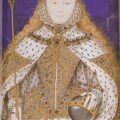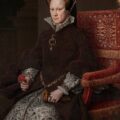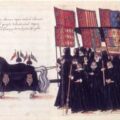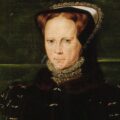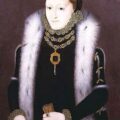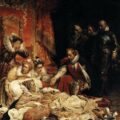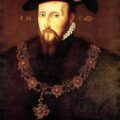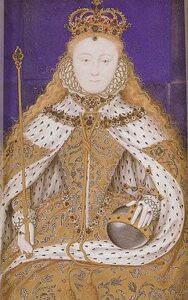
Elizabeth had inherited the throne from her half-sister Mary I, who had died on the 17th November 1558, and the lavish coronation had been planned for the 15th January on the advice of the Elizabethan scholar, astrologer, mathematician and astronomer, John Dee. Elizabeth’s childhood friend, Robert Dudley, had advised Elizabeth to ask Dee to draw up an “electional chart” to find the most auspicious date and time for her coronation, for the birth of a new age. Dee was obviously restricted by time, in that the coronation needed to take place within a few months of Elizabeth’s accession, so he chose the 15th January as the best date, although it was not perfect. You can read more about the Coronation chart he drew up in “Elizabeth I’s Coronation Chart”.
The Coronation Procession
The date was set and preparations began in earnest. Elizabeth did not order a whole new coronation outfit, instead, she showed her practical side and her interest in economising, by recycling her half-sister’s hand-me-downs. She had Mary’s coronation mantle and matching dress altered to wear in her coronation portrait and also for the eve of coronation procession, and then she wore Mary’s crimson velvet parliament robes as she walked from Westminster Hall to Westminster Abbey. The purple velvet robes of estate were, however, specially made for the new queen.
Three days before the coronation, on the 12th January, Elizabeth travelled to the Tower of London to prepare for her coronation. We can only imagine the thoughts running through her head as she stayed in the royal lodgings there – the Tower had been her prison just a few years previous and it had also been the prison and place of death of her mother, Anne Boleyn, and many people she had known and been close to. Elizabeth left the Tower for her eve of coronation procession at 3pm on the 14th January in a cloth of gold covered litter carried by two mules. David Starkey writes of how, as she left the Tower and passed the menagerie, Elizabeth prayed to God, thanking him for her deliverance, like that of Daniel from the lion’s den. Although Starkey comments on how theatrical this was, she surely had much to be thankful for.
Elizabeth was a natural. She charmed the crowd, smiling warmly at people, joking and replying to their good wishes, here was a true queen of the people and her people loved her.
It was usual for pageants to be part of a coronation procession and Elizabeth had five:-
- Gracechurch Street – This pageant referred to Elizabeth’s genealogy, her Tudor roots and the history of the House of Tudor. The people were reminded that her name sake and grandmother Elizabeth of York had brought peace to the land by marrying Henry Tudor and uniting the warring Houses of York and Lancaster. Elizabeth too would bring peace and unity to the land.
- Cornhill – This pageant referred to Elizabeth’s new government as being upheld by four virtues: True Religion, Love of Subjects, Wisdom and Justice.
- Soper’s Lane – This pageant was based on the New Testament Beatitudes and, as Starkey explains, applied them to Elizabeth’s sufferings at the hands of her sister.
- Little Conduit, Cheapside – This pageant with its subject of “Time” attacked Mary’s reign contrasting “a decayed commonwealth” to “a flourishing commonwealth” in two tableaux. Time’s daughter, Truth, carried an English Bible labelled the “Word of Truth” which Elizabeth’s government was said to possess. When Elizabeth saw this pageant, she asked for the Bible and “kissed it, and with both her hands held up the same, and so laid it on her breast, with great thanks to the City therefore.”
- Fleet Street – This pageant depicted Elizabeth as the prophetess Deborah who had rescued Israel from Jabin, King of Canaan. Like Deborah, Elizabeth would reign over her people for over 40 years.
The Coronation Ceremony
Elizabeth’s coronation day began in Westminster Hall, which had been decorated with her father’s sumptuous tapestries and his collection of gold and gilt plate. Blue cloth had been laid from the Hall to the Abbey and Elizabeth, wearing her crimson parliament robes, processed along this cloth which Starkey explains was then torn to shreds by people as souvenirs.
Elizabeth processed to the crossing in the Abbey and withdrew to a curtained enclosure to change. She was then led by Oglethorpe, Bishop of Carlisle, up on to the stage where he proclaimed her queen in each of the four corners, asking the congregation if they would have her for their queen and listening for their enthusiastic replies of “Yea! Yea!”. Elizabeth then made the traditional offerings at the altar and then sat in the throne of estate to listen to the sermon. After the sermon, Elizabeth knelt for the Lords Prayer, took the oath and then withdrew to the traverse to change for the anointing part of ther service. Wearing a kirtle of gold and silver and leaning on cloth of gold cushions, which had been placed before the altar, Elizabeth was anointed on the shoulder blades, breast, arms, hands and head. She was then dressed in white gloves, a white coif and the white dalmatic (tunic) of a deacon. Now that she had sworn the oath and been anointed, she could sit in St Edward’s Chair and receive the sword, armils, mantle, ring and sceptre, and be crowned. She was crowned with three different crowns, one after the other, with fanfares marking each crowning.
Elizabeth was then dressed in gold , right down to her shoes, and with the sceptre in one hand and orb in the other, she processed onto the stage where she sat in the throne where her people greeted her and Oglethorpe and the Lords Spiritual and Temporal paid homage to their new queen by kneeling at her feet and kissing her cheek. The coronation pardon was then read and this was followed by the coronation mass, which included the Epistle and the Gospel being read out in both Latin and English. Elizabeth then kissed the Bible. Oglethorpe then defied his new queen by elevating the host, at whic point Elizabeth withdrew to change into her purple robes. The Queen then processed from the Abbey, through Old Palace Yard and back to Westminster Hall to enjoy her coronation banquet. Elizabeth was now the official queen and her coronation and accession had been a huge success.
Notes and Sources
- Elizabeth, David Starkey
littlemisssunnydale’s YouTube channel has clips from David Starkey’s series on Elizabeth – see Elizabeth I – Coronation for the video on Elizabeth’s coronation.
